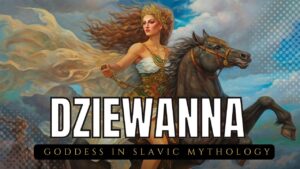Delve into the enchanting realm of Slavic mythology with our in-depth exploration of Dziewanna, the lesser-known but fascinating goddess of wildlife and the hunt. Revered in ancient lore, Dziewanna embodies the untamed spirit of nature and the primal essence of the wilderness. Our blog post unveils the myths, symbols, and cultural significance of this enigmatic deity, offering a unique glimpse into the rich tapestry of Slavic folklore.
Dziewanna story is one of a kind and very interesting. Dziewanna is the daughter of Perun, the wind god, and Mokosh, the Great Mother and protector of women. She is also the daughter of Morana, the winter goddess, Jaryo, the spring and fight god, and Year, the spring goddess. From the moment she was born, she had a free spirit. She learned to be a good ranger and trained wolves and foxes, but they never left her part. Because of all of this, Perun had a hard time keeping her in line, which is where her story began. Because Dziewant loved her freedom so much, she couldn’t sleep without it.
The strong male gods, on the other hand, didn’t like how she let her be wild. The father of the girl thought she was too young and full of herself. He was mad at her because she didn’t tie her hair like single women should and always went hunting. She didn’t want to get married to anyone, as this showed. After that, she fought back.
Each group had its own ideas about which god was the most important. Dziewanna believed she had to be in charge of the three gods’ realms, which were Prawia, Jawia, and Nawia. These were the realms of the living and the dead. The plan was scrapped when the gods learned about it. His roar was so loud that her wolf friends ran away, leaving them alone to fight. He found her in the woods. She got on her horse and used arrows or even a spear to fight her father, but he was too strong. Like many other gods, Dziewant could change how they looked. In order to beat her father, she was so smart that she turned into a tiger. But Perun was just as good. She changed once more. She changed into a bird this time. But Perun changed into an eagle and grabbed her. She finally changed into a fish and swam away from him. The person who saw her fall told Mokosz to catch her with a fishing net. When his wife replied, Dziewant stopped his resistance.
Because of what she did, Perun made his daughter marry Veles, the underworld god in charge of cattle, magic, and the plains. The princess didn’t want to get married and fought against it. In the end, Wales turned into a basil flower and relaxed her heart. These stories say that they are still a strong pair even though they are not dating. In Slavic mythology, there were many nature guardians, and they were very different based on the tribe and region. It’s not clear which groups worshiped which gods, but among west Slavs, Dziewant is often seen as the god of the wildest parts of nature. She and her husband Wales, who was in charge of many hearts in many groups, were married. On the other hand, ywia and Vesna were more often connected to the parts of nature that people knew about. Dziewant to, on the other hand, stood for the plants and animals that lived beyond.
It’s even less clear what these roles are when you think of Dziewant as the opposite of Marzanna, the winter goddess. This story is also from the area, but it is told in many Slavic tribes the same way. It says that around the spring equinox, the god of spring kills Marzanna as part of a festival called “The Drowning of Marzanna” and helps spring come back to life. She kills the same spring god again in the fall, though. When gods die, they go to Nawia, which is the abyss, until they come back. Feminists who talk about Slavic folklore today often talk about Dziewant as a goddess they like. She stands for freedom against traditional roles for women because she wears her hair down and is known as the “wild goddess.” She is also a little different from Mokosz in this way. Instead of being Perun’s wife and the mother of many gods, like her mother does, Dziewant doesn’t.
In most art, Dziewant is a young woman with brown or golden hair that is still alive and a wolf or fox by her side. She could wear either of these animals’ furs or a carry, which is a Welsh design. She sports antlers or a throne made of them sometimes to show that she rules over the pets in the wild. Because she is the goddess of hunting, she is often shown with an arrow and bow. People, especially women, usually think of her as a friend, even though she can be meaner than most gods because of how she looks.






